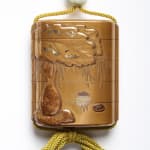Hara Yōyūsai 原羊遊斎
Inro with Gift from the Ise Stories, early–mid 19th century
Maki-e gold lacquer on wood
Size 2 3/4 x 2 1/4 in. (7.4 x 6.2 cm)
T-4051
Further images
-
(View a larger image of thumbnail 1
)

-
(View a larger image of thumbnail 2
)

-
(View a larger image of thumbnail 3
)

-
(View a larger image of thumbnail 4
)

-
(View a larger image of thumbnail 5
)

-
(View a larger image of thumbnail 6
)

-
(View a larger image of thumbnail 7
)

-
(View a larger image of thumbnail 8
)

-
(View a larger image of thumbnail 9
)

-
(View a larger image of thumbnail 10
)

Four-case inrō (interlocking medicine case) of oval section with applied cord-runners, decorated in gold, silver, and colored hiramaki-e and takamaki-e with shell inlay and gold kirigane and e-nashiji against a...
Four-case inrō (interlocking medicine case) of oval section with applied cord-runners, decorated in gold, silver, and colored hiramaki-e and takamaki-e with shell inlay and gold kirigane and e-nashiji against a gold fundame ground, depicting a bronze ewer, three scrolls, a sudare (split-bamboo curtain) and its tassels, a tripod kōro (incense burner), an inlaid incense box, and a takatsuki (singled-legged tray), itself decorated with hōō birds and paulownia, bearing a mass of seaweed topped with an oak leaf inscribed kimi ga tame ni wa (see below); the compartments and risers gold nashiji; the shoulders and rims gold fundame
Signed on the base with gold hiramaki-e characters Yōyūsai 羊遊斎 with a red kaō (artist’s monogram)
This design is based on a poem in Chapter 87 of Ise monogatari (The Ise Stories), a classic early sequence of narratives and poems centered around a “certain man,” generally accepted to be the courtier-poet Ariwara no Narihira (825–880). The syllables kimi ga tame ni wa come from the last poem in the chapter, where a party of courtiers spend a stormy night in a seaside mansion. In the morning the servants gather seaweed which the lady of the house presents to her guests, topped with an oak leaf inscribed with a poem:
わたつみのかざしにさすといはふ藻も君がためには惜しまざりけり
Watatsumi no / kazashi ni sasu to / iwau mo mo / kimi ga tame ni wa / oshimazarukeri
Even though the gods / of the ocean need seaweed / to adorn their heads / ungrudgingly they bestowed / this gift upon you, my lords
For a similar lacquer design, applied to a set of writing box and document box, see Grace Tsumugi Fine Art, Japanese Works of Art, London, 2015, cat. no. 8.
Ise monogatari was much used as a source of subject-matter by the painter Sakai Hōitsu (1761–1828), whose designs were frequently adapted by Hara Yōyūsai, the maker of this piece. Although in this case Yōyūsai did not follow his customary practice of applying Hōitsu’s signature to the piece alongside his own, it is likely that the original design was from Hōitsu’s hand.
Signed on the base with gold hiramaki-e characters Yōyūsai 羊遊斎 with a red kaō (artist’s monogram)
This design is based on a poem in Chapter 87 of Ise monogatari (The Ise Stories), a classic early sequence of narratives and poems centered around a “certain man,” generally accepted to be the courtier-poet Ariwara no Narihira (825–880). The syllables kimi ga tame ni wa come from the last poem in the chapter, where a party of courtiers spend a stormy night in a seaside mansion. In the morning the servants gather seaweed which the lady of the house presents to her guests, topped with an oak leaf inscribed with a poem:
わたつみのかざしにさすといはふ藻も君がためには惜しまざりけり
Watatsumi no / kazashi ni sasu to / iwau mo mo / kimi ga tame ni wa / oshimazarukeri
Even though the gods / of the ocean need seaweed / to adorn their heads / ungrudgingly they bestowed / this gift upon you, my lords
For a similar lacquer design, applied to a set of writing box and document box, see Grace Tsumugi Fine Art, Japanese Works of Art, London, 2015, cat. no. 8.
Ise monogatari was much used as a source of subject-matter by the painter Sakai Hōitsu (1761–1828), whose designs were frequently adapted by Hara Yōyūsai, the maker of this piece. Although in this case Yōyūsai did not follow his customary practice of applying Hōitsu’s signature to the piece alongside his own, it is likely that the original design was from Hōitsu’s hand.
Exhibitions
WAS 2019









